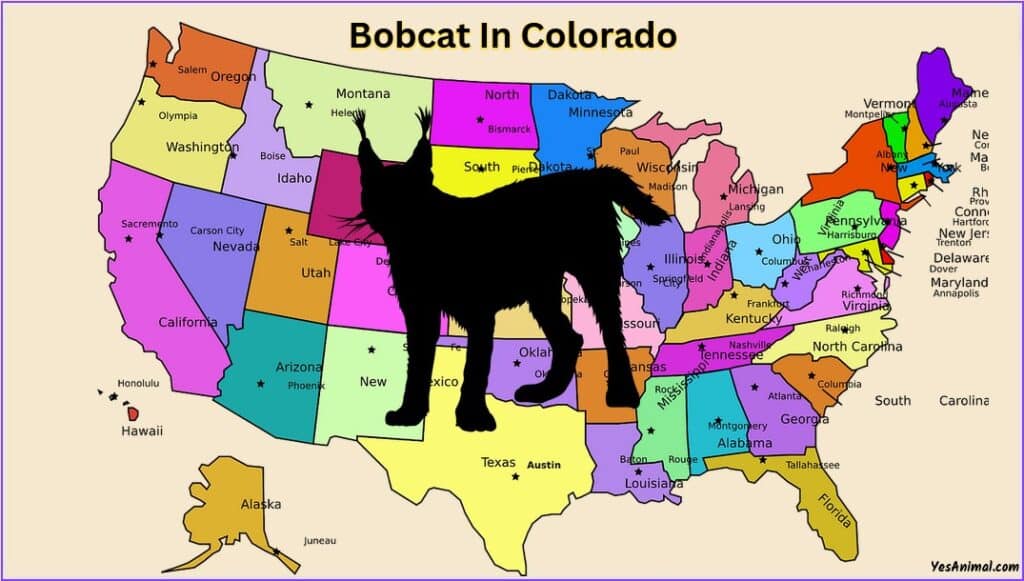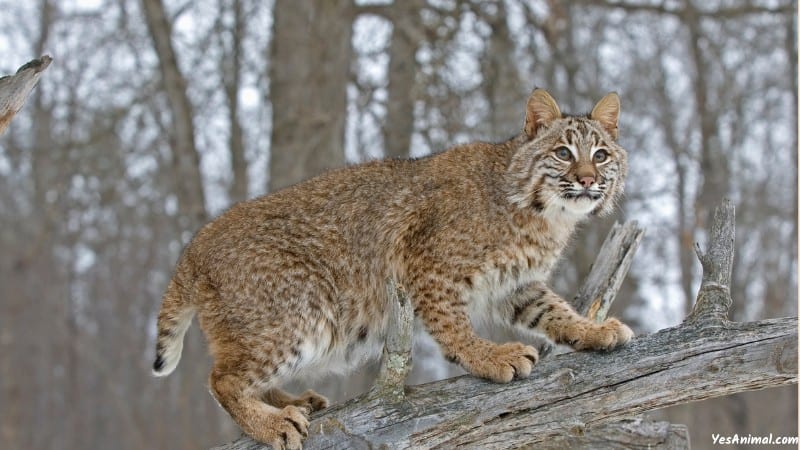Last Updated on September 14, 2023 by Amin Tawar

From majestic black bears to magnificent buffalo, Colorado is home to a variety of large animals. They roam through its ravines, wild cliffs, prairies, and woodlands. And one such creature is the bobcat.
Below In this article, I’ve explained everything you need to know about the bobcats in Colorado.
Are There Bobcats In Colorado?
Bobcats exist throughout North America, including Colorado. An estimation of impressive 12,000 bobcats is present in Colorado. In recent years, bobcat reporting has grown in Colorado, as the hunting areas of the animals are being developed into cities.
Where Do Bobcats Live In Colorado & How Common Are They?
Bobcats are known for their adaptability and can survive in a variety of habitats, varying from coastal swamps to northern boreal forests, to scrublands and deserts.
Their adaptability to different habitats is the main reason for them to be found in nearly all states of the U.S. as well as vast swaths of Northern Mexico and Southern Canada.
In Colorado, bobcats are mostly found in foothills, mesas, canyons, and plateaus, where woodland and brush provide shelter for them.
As bobcats are territorial, they mark their range with feces and urine. Males go up to 30 square miles, whereas females keep it small, which is only 5 square miles. This allows them to stay near their shelters to watch for their younger ones.
With more than 12,000 bobcats in the state, you might think it is easy to spot one. No, bobcats are very elusive in nature and they hide from humans. Probably when you are on a hike or camping then there are chances for you to meet one in the wild.
How Large Is A Colorado Bobcat?
Bobcats are big wild cats native to North America. An adult bobcat can grow up to 40 pounds in weight and 37 inches long in height. The averages about 8 to 12 pounds and 28-inch height.
They are more like a little shorter than a fully-developed coyote. Congruous with their name, they have short tails, that are about 6 inches long, which look “bobbed.”
They have brown fur with white bellies, black spots, and white facial accents. The hair on their cheeks is in a ruff and has furry ends on their ears. They have great hearing, eyesight, and smell sense. They are heavily muscled and armed with sharp claws and teeth. Such big carnivores are fully equipped for self-defense and hunting.
Are Bobcats Aggressive In Colorado?

Bobcat attacks on humans are very rare, as they are timid. When a bobcat is sick, hungry, in the mating season, or protecting young, these rare occasions can make them aggressive.
If you do encounter one make sure to give it space and observe it from as far as possible.
Also Check Our Guide On Bobcats In US
What Do Bobcats Eat In Colorado?
Bobcats usually prey on smaller animals like rabbits, mice, rats, and squirrels. Sometimes they do prey on young deer who are weakened by injury, age, or illness. Just like other carnivorous animals, bobcats play an important role in maintaining the inhabitants of small vermin and herbivores.
If these animals were left unchecked to multiply, they can spread disease, eat down vegetation, and damage crops. This would have a declining environmental impact, as the reduction of the ground surface would increase water pollution and erosion levels.
Can You Kill A Bobcat In Colorado?
With an estimate of more than 12,000 bobcats roaming in Colorado, they are far from threatened species. Their populations have only been increasing since the 1990s, in every state including Colorado.
In 2022, a ruling that might have restricted bobcat hunting in Colorado was overthrown, so it is still lawful to hunt bobcats with a proper license in the state. The hunting season is from December to February. They can be hunted night or day with no seasonal or bag limits. They are tracked to bag a trophy or to collect their furs to sell.
Can You Own A Bobcat In Colorado?
In Colorado, the Division of Wildlife allows the owning of bobcats only for commercial purposes. Specific requirements; a plan to establish a profit, maintain business records, must have experience, hire and train employees, caging requirements, Federal income tax, etc. are needed. Owning of hybrid is not illegal. They can be illegal in a few Colorado cities like Denver.
What To Do If You See A Bobcat In Colorado?
If you spot a bobcat when hiking, you can follow these precautions to protect yourself from it.
- Slowly back away as you watch the cat.
- Never take your eyes off the cat or show your back to it.
- Do not run, as it can trigger its instinct to follow its prey.
- Try making much distance between the cat and you.
- Create loud noises like banging your camping posts together, hitting your hiking pole, or blowing a whistle.
- Throw things, like sticks, rocks, or other items from your campsite.
Also Check Our Guide On Bobcats In Arkansas
Conclusion
And that was everything you need to know about the Bobcats in Colorado. I hope this article was informative and your queries were answered.
Thank You For Reading!
Our Goto Source For This Guide